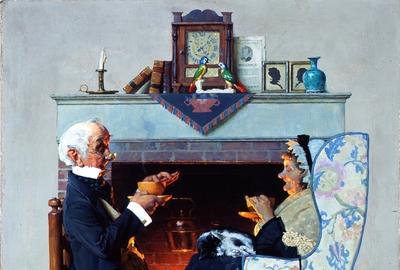John Sloan's Yolande in Gray Tippet, 1909
- October 21, 2010 10:10
In this half-length portrait, a young brunette woman peeks flirtatiously at the viewer from the corners of her almond-shaped eyes. There is a hint of a smile on her closed lips, and a rosy hue tinges the contours of her high cheekbones. Her body is angled away from the viewer, and she tips her head ever so slightly forward. A mound of thick, dark brown hair crowns her pretty, creamy-complexioned face, and a large black bonnet extends outward from the back of her head. She wears a loosely painted maroon jacket and a gray, fur tippet—or scarf—around her neck. A matching gray and white muff hides her hands from view. Her body is surrounded by a neutral, golden-brown background.
On November 9, 1909, the American artist John Sloan hired what he described as "an odd sort of young girl," seventeen-year-old Yolande Bugbee, to be his model for one week. He completed Yolande in Gray Tippet in three sessions from the 10th until the 12th of November, and was "elated" by the results. Sloan produced another portrait of Yolande before the week was out, and was so pleased that he hired her for a second week. By 1911, Sloan had produced six portraits of Yolande, two of which he submitted to the 1910 exhibition of the National Academy of Design in New York.
In previous years he had worked full-time as a newspaper and magazine illustrator, a job that forced him to relegate the practice of painting to his spare time. Nonetheless, he had been an eager student of William Merritt Chase and Thomas Anshutz in evening classes at the Pennsylvania Academy of the Fine Arts between 1892 and 1894. Perhaps the most important influences on Sloan’s artistic development were those of painter Robert Henri and Sloan’s colleagues in the newspaper illustration business—George Luks, William Glackens, and Everett Shinn—whom he joined in New York in 1904. Sloan’s early work shared with Henri and the others a dark palette and swift brushwork, as demonstrated in Yolande in Gray Tippet. The painters generally represented urban scenes, especially of the poor and lower classes. When Sloan, Henri and their associates staged an exhibition under the title The Eight in 1908, critics dubbed them “The Apostles of Ugliness” for their dark, straightforward depictions of the seamier side of life in New York City.
In 1913, the Armory Show in New York exposed Sloan to Post-Impressionist and avant-garde European artists whose works changed his esthetic purview. He was inspired to investigate anew the formal qualities of art, especially color. The Norton’s Passing through Gloucester (adjacent gallery) is one of almost 300 paintings he created from 1914 to 1918. In his later works, he extended his investigations into form and color relationships to images of female nudes. He developed a new technique for these paintings in which he first created a monochrome drawing and then applied layers of color, often in cross-hatched markings.
Towards the end of Sloan’s life, he painted two more portraits of Yolande at the model’s request. The changes in his artistic style as it developed and matured are manifest in the eight paintings of Yolande, from the earliest image of her in the manner of Robert Henri, to the last painting in Sloan’s unique cross-hatching style.
Trust Gallery, American Wing
John Sloan (American, 1871-1951)
Yolande in Gray Tippet, 1909
Oil on canvas
Bequest of R.H. Norton, 53.179





100x100_n.jpg)
100x100_c.jpg)













